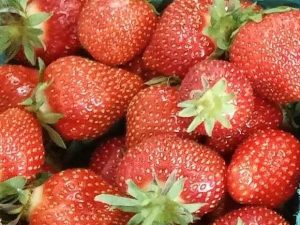2018 Cooperators’ Program Year in Review
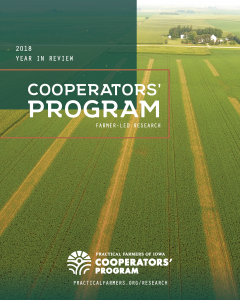 Farmers in Practical Farmers’ Cooperators’ Program conduct on-farm research experiments and demonstrations to better answer their most challenging questions. Knowledge from these research trials helps equip farmers to be more profitable, to be better environmental stewards and ultimately, to make their farms and communities more resilient. This research has not only influenced other farmers – it has shaped some of the most important university research coming out of the state over the past few decades. Since 1987 when the Cooperators’ Program began, 240 different cooperators have conducted over 1,400 research trials on their farms.
Farmers in Practical Farmers’ Cooperators’ Program conduct on-farm research experiments and demonstrations to better answer their most challenging questions. Knowledge from these research trials helps equip farmers to be more profitable, to be better environmental stewards and ultimately, to make their farms and communities more resilient. This research has not only influenced other farmers – it has shaped some of the most important university research coming out of the state over the past few decades. Since 1987 when the Cooperators’ Program began, 240 different cooperators have conducted over 1,400 research trials on their farms.
EXPERIMENTS are trials that involve a rigorous, scientific design. This means treatments are applied to randomized and replicated plots in a farmer’s field. Conclusions are based on statistical analysis of the results much like academic research studies.
DEMONSTRATIONS are trials that involve making observations of two or more management strategies or keeping detailed records of production practices. Strategies or practices are typically only replicated once in part of a field or bed, or among a group of animals. This doesn’t allow for statistical analysis of the results, but cooperators draw meaningful conclusions that inform their production systems, and some demonstrations eventually evolve into experiments.
Read the PDF version of the year in Review
Research featured in the Year in Review
Field Crops
Planting Corn in 60-in. Row-Widths For Interseeding Cover Crops
Interseeding cover crops to corn at the V4 stage has had mixed success, likely because of shading by the tall corn canopy later in the season has hindered cover crop growth. Seeding a cover crop at this time of year (early June) is appealing to farmers because it presents opportunities for an abundance of cover crop species like cowpeas, sunn hemp, radish, buckwheat and many others that cannot be seeded in the fall in Iowa.
Establishing Cover Crop Skip Zones for Corn
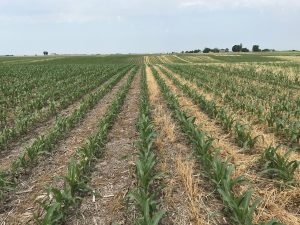 Proper management is required for successfully overcoming yield drag in corn following a cereal rye cover crop. This typically involves waiting 10-14 days between cover crop termination and corn planting, as well as applying some nitrogen fertilizer near the time of planting. Removing the influence of a cover crop from the eventual corn row zone may be another practice that falls under the category of proper management.
Proper management is required for successfully overcoming yield drag in corn following a cereal rye cover crop. This typically involves waiting 10-14 days between cover crop termination and corn planting, as well as applying some nitrogen fertilizer near the time of planting. Removing the influence of a cover crop from the eventual corn row zone may be another practice that falls under the category of proper management.
No-Till Vs. Strip-Till Corn and Soybeans Following a Cereal Rye Cover Crop
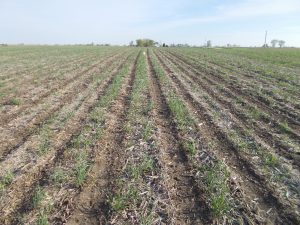 A successful management strategy for corn and soybeans following a cereal rye cover crop may differ across farms in terms of tillage, nitrogen fertilizer application or both. This study looked at the effect of no-till and strip-till on corn and soybeans when following a cereal rye cover crop. The three farmers involved wanted to know if corn or soybean yields, and returns on investment, could be improved with strip tillage in a cover crop system.
A successful management strategy for corn and soybeans following a cereal rye cover crop may differ across farms in terms of tillage, nitrogen fertilizer application or both. This study looked at the effect of no-till and strip-till on corn and soybeans when following a cereal rye cover crop. The three farmers involved wanted to know if corn or soybean yields, and returns on investment, could be improved with strip tillage in a cover crop system.
Cereal Rye Cover Crop for Reducing Herbicides in Soybeans
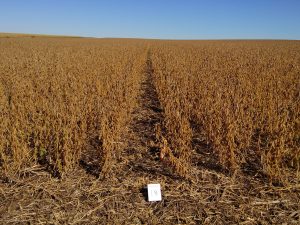 The costs associated with planting and managing cover crops are a barrier to adoption for many growers, despite the benefits to weed control and soil and water quality. Sam Bennett has been growing cover crops in his corn and soybean rotation for several years and has observed their positive impacts on his farm’s soil quality and weed control.
The costs associated with planting and managing cover crops are a barrier to adoption for many growers, despite the benefits to weed control and soil and water quality. Sam Bennett has been growing cover crops in his corn and soybean rotation for several years and has observed their positive impacts on his farm’s soil quality and weed control.
Horticulture
Strawberry Establishment and Production Enterprise Budget
Locally grown strawberries are in high demand at markets, but the time and labor demands of growing them make strawberries a trickier crop to manage than many realize. The plants require a year to establish before the first harvest, and preventing competition from weeds is critical. In this demonstration, Lee Matteson and Rose Schick compared the enterprise budgets for four strawberry varieties that were established using two different methods: matted rows mulched with cornstalk mulch, or planted into biodegradable plastic mulch.
To meet the desires of their customers, farmers are interested in finding varieties of head lettuce most tolerant to the heat of summer that taste acceptable and work in their production system. In a 2017 summer lettuce variety trial, Magenta had the highest yields on three of the six cooperating farms, and showed the best tolerance to heat.
Enterprise Budget for Cherry Tomatoes
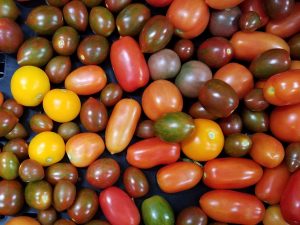
Farmers plant and manage cherry tomatoes according to their own timing, markets and preferred practices. But how do these choices affect production costs and labor efficiency? In this enterprise budget study, two cooperating farms – including Emma and Marcus Johnson, of Buffalo Ridge Orchard, and Derek Roller and Molly Schintler, of Echollective Farm – tracked data on cherry tomatoes raised in a high tunnel that were trellised to maximize space and lengthen the harvest window. The data collected from each farm was standardized to provide insight into cost and labor efficiency at each farm.
Livestock
Fatty Acid Composition of Grain and Forage-Fed Pork
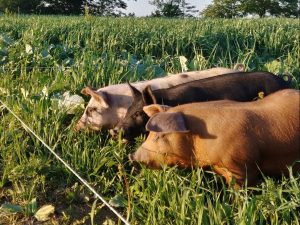 Raising pigs on pasture increases their exposure to and intake of forages, which can in turn affect the fatty acid composition of pork. Grass-fed animal fats contain higher proportions of omega-3 fatty acids than grain-fed animals. Pork that is predominantly grain-fed usually has a higher ratio of omega-6 to omega-3 fatty acids. This demonstration aimed to see if the omega fatty acid ratio could be better balanced by including forage in pigs’ diets. John Arbuckle examined fatty acid composition and feed cost economics from 75 pigs fed three different rations: grain-free, 50% grain and 100% grain.
Raising pigs on pasture increases their exposure to and intake of forages, which can in turn affect the fatty acid composition of pork. Grass-fed animal fats contain higher proportions of omega-3 fatty acids than grain-fed animals. Pork that is predominantly grain-fed usually has a higher ratio of omega-6 to omega-3 fatty acids. This demonstration aimed to see if the omega fatty acid ratio could be better balanced by including forage in pigs’ diets. John Arbuckle examined fatty acid composition and feed cost economics from 75 pigs fed three different rations: grain-free, 50% grain and 100% grain.
Fatty Acid Composition of 100% Grass-Fed Beef
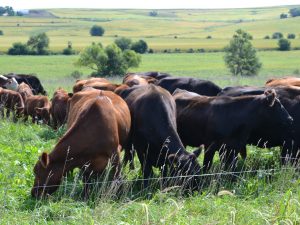 Advocates of grass-fed and grass-finished beef claim that it contains a healthy balance of omega fatty acids. The American Heart Association recommends an omega-6 to omega-3 ratio for human diets of 4-to-1. On average, grain-fed beef has an omega-6 to omega-3 ratio of 8-to-1. Increased consumption of omega-3 fatty acids is known to decrease the risks of cardiovascular and autoimmune diseases.
Advocates of grass-fed and grass-finished beef claim that it contains a healthy balance of omega fatty acids. The American Heart Association recommends an omega-6 to omega-3 ratio for human diets of 4-to-1. On average, grain-fed beef has an omega-6 to omega-3 ratio of 8-to-1. Increased consumption of omega-3 fatty acids is known to decrease the risks of cardiovascular and autoimmune diseases.
Research has found that a ratio of 2.5-to-1 reduced cancer cell proliferation, and anti-aging experts tout ratios of 2-to-1. For this study, a combined 27 ribeyes from two farms – Carney Family Farms in Maxwell and Troublesome Creek Cattle Co. in Exira – were sent to laboratories at Iowa State University and analyzed for fat content and other attributes. These ribeyes came from Red and Black Angus and Angus Cross grass-fed cattle. They were finished between 20 and 32 months old, with carcass weights ranging from 528 pounds to 772 pounds.
More research reports are on the way! To see all of our research head to practicalfarmers.org/research.


